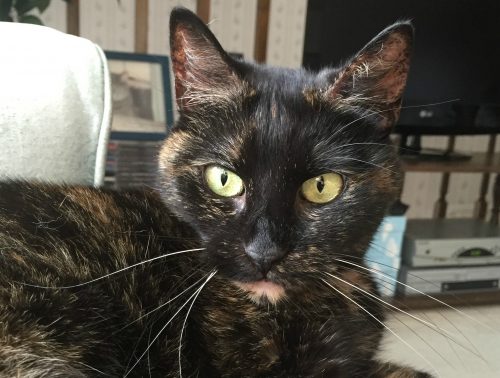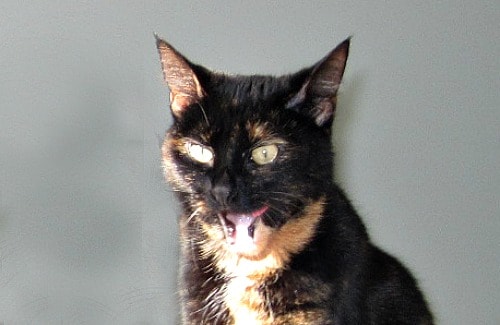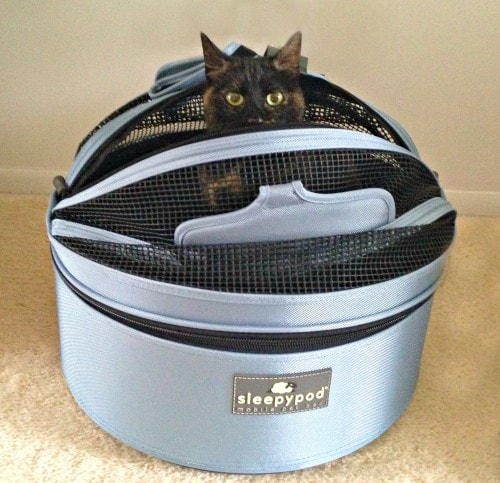
Finding out that your cat needs dental work provokes anxiety in most cat guardians, and I’m not immune to those fears. Despite my years of working in veterinary clinics, and having been through many dental procedures with the cats that came before Allegra and Ruby, there’s not much that makes me feel as anxious as the thought of one of my babies having to undergo anesthesia. A year and a half ago, I shared my experience about Allegra’s dental procedure in a four part series. Last month, it was Ruby’s turn.
I’m sharing my recent experience with Ruby in hopes that it will not only put your minds at ease if you’re faced with a cat who has to have a dental procedure, but that it will also help you ensure that your cat gets the optimal level of care before, during and after her dental work.
The importance of dental health
Dental disease is the most frequently diagnosed health problem for cats. According to the American Veterinary Dental Society, an astounding 70 percent of cats show signs of oral disease by age 3.
Normal teeth should be white or just a little yellow. Gums should be light pink and smooth (except in breeds with pigmented gums). Oral disease begins with a build up of plaque and tartar in your cat’s mouth. Without proper preventive and therapeutic care, plaque and tartar buildup leads to periodontal disease, which manifests in red and/or swollen and tender gums, bad breath, and bleeding. When the gums are swollen, they can be painful – a good rule of thumb is that if it looks like it might be painful, it probably is. Cats are masters at masking pain – when in doubt, assume that your cat is experiencing at least some discomfort.
The inflammation and infection associated with periodontal disease can lead to damage to other organs such as the heart, kidney and liver, and lead to other serious health problems. Dental disease can also be an indicator of immune system disorders.
Ruby’s diagnosis
Allegra and Ruby get bi-annual exams by our wonderful holistic housecall vet, Andrea Tasi, VMD of Just Cats Naturally. At seven and six years old, their teeth and gums, until recently, had been in remarkably good shape on visual exam. These are the first cats for whom I’ve practiced daily brushing, and it is reassuring to me that it has been making such a difference. All my other cats have needed dental cleanings annually or at least every other year.
Allegra had her first dental procedure September of 2015 after Dr. Tasi found evidence of a resportive lesion, also referred to as feline odontoclastic resorptive lesions (FORLs), or Tooth Resorptive Disease of Felines (TRDF.) Tooth resorption is common; estimates are the condition affects between about 30 to 40 percent of healthy adult cats, and is diagnosed in 60 to 80 percent of cats who visit the vet for treatment of dental disease.
Tooth resorption is a progressive disease which begins with erosion of the surface layer of the root and then moves into the center of the tooth and the pulp. The resorption process continues until the enamel is completely resorbed, which can cause the tooth to fracture and/or remodel into a lump on the gum line.
As you can probably guess from this brief description, this is a painful condition. Since cats rarely show signs of pain unless the lesion is touched directly, this condition can only be diagnosed by a veterinary exam. Allegra had been reacting with some sensitivity in that area during brushing for a few weeks preceding the exam.
Up until her most recent exam by Dr. Tasi, Ruby had had some mild to moderate gingivitis. Ideally, this should have been addressed, but since Ruby gets extremely stressed even during Dr. Tasi’s home visits, we had to weight the stress of taking her to a clinic against the benefit of the procedure. However, this time, there was no question that Ruby needed dental work. In the weeks leading up to our appointment with Dr. Tasi, I had noticed an increasingly bad odor coming from Ruby’s mouth. She also drooled more than her normal “happy drooling.” During her exam, Dr. Tasi found several resorptive lesions in progress. It was time, probably past time, to schedule Ruby’s procedure.
Choosing a veterinary dentist for Ruby
Many general practices perform dentistries, but unless a practice is equipped to take and properly interpret dental radiographs, and unless a veterinarian is very experienced with complex dental procedures, a veterinarian who is board certified in veterinary dentistry is a better choice. A visual oral exam is rarely enough to properly diagnose dental disease. “When I recommend what I think might simply be a routine dental prophylaxis (cleaning and polishing), I warn my clients that there might be much more going on inside a cat’s mouth than meets the eye on even a careful and thorough physical exam, and that extractions are often needed,” says Dr. Tasi.
Regardless of whether you choose a general practice of a specialist for your cat’s dental procedure, make sure that you ask these 13 questions before scheduling your cat’s appointment.
For me, the choice was easy: Dr. Chamberlain at Animal Dentistry and Oral Surgery in Leesburg, VA. It’s where Allegra went in 2015. It’s also where Dr. Tasi takes her own cats, and if she trusts Dr. Chamberlain with her own cats, that’s good enough for me. “I know that the services provided will be the highest standard of care”, says Dr. Tasi, “and that any challenge my patients’ mouths present will be handled with the expertise of a board certified specialist in dentistry.”





LOVE Dr. Chamberlain and his group. My Hanna had the best possible care there after two horrific visits to another hospital. Even though it is an hour’s drive away – I would go to no other dentist.
My friend has an 8 year old. GC recently went through a dental procedure. The question prior to the procedure was did the owner (Mom) want a heart monitor during the procedure? She, of course, said ‘yes’. GC’s heart stopped during the procedure, and it was only because of the monitor that he lived to tell his story. Why, oh why, don’t vets just say, “We put monitors on during the procedure, AND we give pain killers afterwards.”? I can’t tell you how many times I’ve been in the waiting room, and the vet clerks ask if the clients want pain killers for their pets. Vets should automatically say, “This is the procedure, we put monitors on and we give pain killers, and THIS is the price.” No more questions. I find it abominable that pain killers after the procedure should even be a question.
It’s shocking to me that there are still vets out there that consider pain control (or monitors, for that matter) optional. It’s unconscionable, as far as I’m concerned.
Thank you for the post.
Thanks for this informative post. It answered some questions I had.
Ingrid,
Not only are dental procedures hard on cats/kittens, so are they on their humans. I too, hate going to the dentist!
Look forward to part 2 of, Ruby’s dental experience.
So do I, Nancy!
This really is most interesting and informative; look forward to next instalment…. can well sympathise with it all. Strange that some cats succumb early to dental disease and others sail through their lives without. One of our previous cats began her problems at three years old, we have one now who is 17.1/2 who has never had a procedure in that area; he has a good few other problems and really is now on borrowed time although doing well enough; his teeth AREN’T good now but unless something dire becomes necessary “we” are leaving it…..”George” undoubtedly will sort himself out one way or the other. That sounds a bit casual and callous – not meant to be.
If he has other issues, have you considered giving him pain meds, just to make his mouth more comfortable?
I had a cat in renal failure with terrible arthritis – vet gave him Onsior daily for over a year to make him more comfortable. The thinking was, “What is it going to do? Kill him?” Well, it didn’t kill him. In fact, some renal cats actually have a slight improvement in kidney numbers on Onsior. And it made my old guy’s remaining time better, so even if it took a month or two off of his life, it was worth it to make that time quality time.
Anesthesia can be tailored even for senior cats with health conditions. Of course, there are cases where other issues may preclude addressing dental issues. Casey’s suggestion is a good one, and may be something you may want to discuss with your vet.